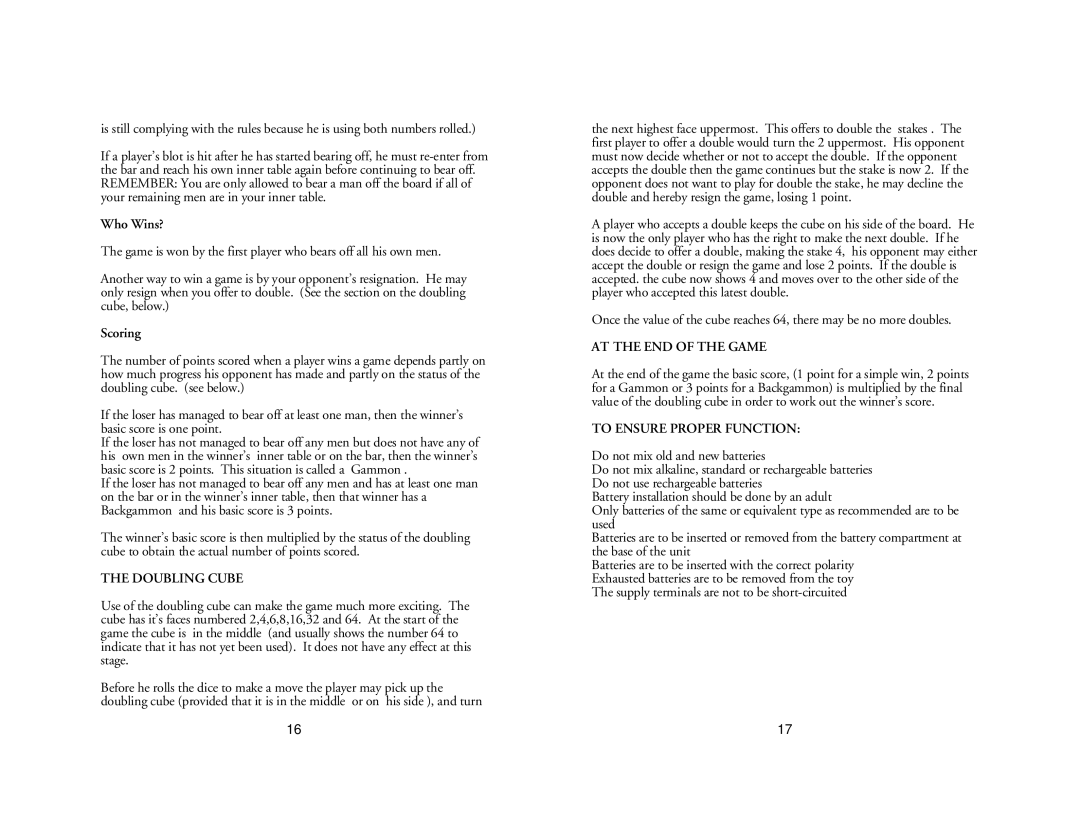is still complying with the rules because he is using both numbers rolled.)
If a player’s blot is hit after he has started bearing off, he must
Who Wins?
The game is won by the first player who bears off all his own men.
Another way to win a game is by your opponent’s resignation. He may only resign when you offer to double. (See the section on the doubling cube, below.)
Scoring
The number of points scored when a player wins a game depends partly on how much progress his opponent has made and partly on the status of the doubling cube. (see below.)
If the loser has managed to bear off at least one man, then the winner’s basic score is one point.
If the loser has not managed to bear off any men but does not have any of his own men in the winner’s inner table or on the bar, then the winner’s basic score is 2 points. This situation is called a Gammon .
If the loser has not managed to bear off any men and has at least one man on the bar or in the winner’s inner table, then that winner has a Backgammon and his basic score is 3 points.
The winner’s basic score is then multiplied by the status of the doubling cube to obtain the actual number of points scored.
THE DOUBLING CUBE
Use of the doubling cube can make the game much more exciting. The cube has it’s faces numbered 2,4,6,8,16,32 and 64. At the start of the game the cube is in the middle (and usually shows the number 64 to indicate that it has not yet been used). It does not have any effect at this stage.
Before he rolls the dice to make a move the player may pick up the doubling cube (provided that it is in the middle or on his side ), and turn
16
the next highest face uppermost. This offers to double the stakes . The first player to offer a double would turn the 2 uppermost. His opponent must now decide whether or not to accept the double. If the opponent accepts the double then the game continues but the stake is now 2. If the opponent does not want to play for double the stake, he may decline the double and hereby resign the game, losing 1 point.
A player who accepts a double keeps the cube on his side of the board. He is now the only player who has the right to make the next double. If he does decide to offer a double, making the stake 4, his opponent may either accept the double or resign the game and lose 2 points. If the double is accepted. the cube now shows 4 and moves over to the other side of the player who accepted this latest double.
Once the value of the cube reaches 64, there may be no more doubles.
AT THE END OF THE GAME
At the end of the game the basic score, (1 point for a simple win, 2 points for a Gammon or 3 points for a Backgammon) is multiplied by the final value of the doubling cube in order to work out the winner’s score.
TO ENSURE PROPER FUNCTION:
Do not mix old and new batteries
Do not mix alkaline, standard or rechargeable batteries
Do not use rechargeable batteries
Battery installation should be done by an adult
Only batteries of the same or equivalent type as recommended are to be used
Batteries are to be inserted or removed from the battery compartment at the base of the unit
Batteries are to be inserted with the correct polarity Exhausted batteries are to be removed from the toy The supply terminals are not to be
17
